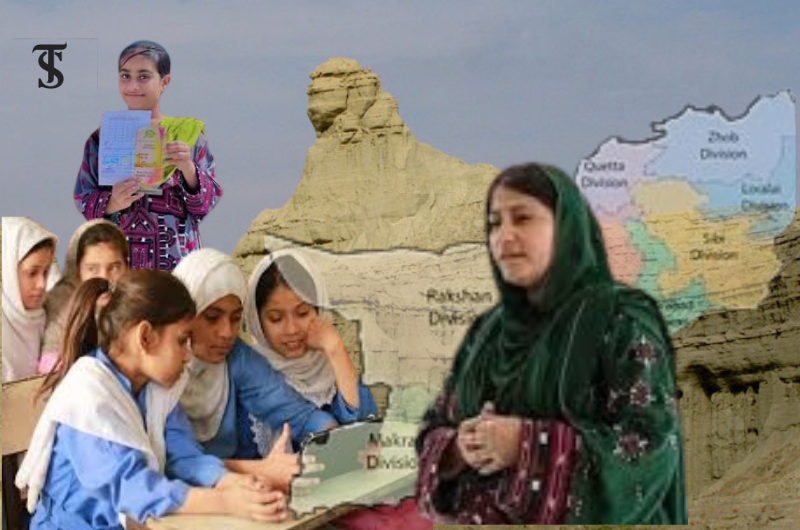The Plights of Girls’ Education in Balochistan

- Cultural norms and economic challenges: Deep-rooted cultural beliefs and widespread poverty in Balochistan prioritize boys' education over girls, significantly hindering girls' access to schooling.
- Infrastructure and security issues: Lack of schools, basic facilities, and security concerns, especially in rural areas, further limit educational opportunities for girls.
- Role of NGOs and potential solutions: NGOs and digital initiatives are crucial in promoting girls' education, but sustainable, community-based, and public-private partnerships are needed for lasting impact.
Girls’ education in Balochistan remains a critical issue shaped by numerous challenges, including cultural, economic, and infrastructural barriers. Despite the constitutional right to education in Pakistan, Balochistan lags significantly behind than other provinces, with girls’ literacy rates among the lowest in the country. According to the Pakistan Bureau of Statistics, the literacy rate for females in Balochistan was only 33% as of 2022, compared to the 46% of overall women literacy rate. Understanding the various factors that impede educational access for girls in this region is essential to devising effective solutions.
Societal Challanges
One of the primary impediment to girls’ education in Balochistan is the deep-rooted cultural norms that prioritize traditional gender roles over formal education. In many communities, girls are expected to manage domestic responsibilities and marry at an early age, leaving little room for schooling. This cultural perspective is reinforced by societal expectations, which often view education for girls as unnecessary or even inappropriate. Early marriages remain a significant issue, with UNICEF reporting in 2021 that 21% of girls in Balochistan are married before the age of 18, further limiting their opportunities for education. The pervasive belief that a girl’s place is in the home, rather than the classroom, significantly reduces the demand for female education.
Economic Constrains
Economic challenges further compound the problem. Balochistan is a region where poverty is widespread, forcing families to make difficult choices about who in the family should receive an education. In many cases, boys are prefered over girls, as educating sons is seen as a more secure investment for the future. The Pakistan Social and Living Standards Measurement (PSLM) survey from 2020-2021 indicated that only 28% of rural girls were enrolled in primary schools, a stark indicator of the economic constraints that limit girls’ educational access.
Additionally, the lack of government funding and resources exacerbates the situation, with many schools lacking basic facilities and educational materials. The budget allocated to education in Balochistan was around PKR 60 billion in 2023, yet the distribution of these funds has been criticized for not effectively addressing the needs of girls’ education, particularly in rural areas.
Lack of Infrastructure
The issue of infrastructure and accessibility also plays a crucial role in limiting girls’ education in Balochistan. The province has a sparse network of schools, especially in rural areas, making it difficult for many girls to attend classes regularly. The distance to schools can be considerable, and in many cases, parents are reluctant to send their daughters on long, often unsafe, journeys. According to a report by the Balochistan Education Management Information System (BEMIS) in 2021, nearly 50% of the girls’ schools in the province did not have boundary walls, and 67% lacked functional toilets, which are critical facilities for ensuring a safe and conducive learning environment. The lack of infrastructure not only discourages attendance but also contributes to high dropout rates.
Securty Concerns
Security concerns in Balochistan further deter parents from sending their daughters to school. The region has been plagued by instability and violence, making educational institutions targets in many cases. The fear of attacks by extremist groups, who often oppose girls’ education, creates an environment of fear and uncertainty. A 2022 report by the Human Rights Commission of Pakistan highlighted several incidents where schools, particularly those for girls, were attacked or threatened, further jeopardizing the already low enrollment rates. This insecurity, combined with existing cultural and economic barriers, significantly reduces the likelihood of girls pursuing education.
Failing to Implement the Policies
Government policies and initiatives aimed at improving girls’ education in Balochistan have had limited success due to various implementation challenges. The National Education Policy of 2017 emphasizes gender equity in education, but its impact in Balochistan has been minimal due to weak provincial implementation. Although there are specific initiatives, such as the Balochistan Education Sector Plan (BESP) 2020-2024, which aims to enhance educational access for girls, progress has been slow.
Corruption and mismanagement have led to the misallocation of resources, with many schools existing only on paper, known as “ghost schools.” For instance, a 2022 audit revealed that over 1,500 schools in Balochistan were non-functional, yet continued to receive government funds. Despite these challenges, there have been some success stories, such as the Tawana Pakistan Project, which provided meals to girls to encourage school attendance. However, these initiatives are often short-lived due to funding issues, underscoring the need for more sustainable and targeted policies that consider the unique cultural context of the region.
Positive Roles of NGOs
Non-governmental organizations (NGOs) and international organizations have played a crucial role in promoting girls’ education in Balochistan, often filling gaps left by government efforts. NGOs like the Balochistan Rural Support Program (BRSP) and international bodies like UNICEF have implemented various educational projects aimed at reaching marginalized girls. For example, BRSP’s community schools have brought education to remote areas, while UNICEF’s “Let Us Learn” initiative has provided educational opportunities for girls who would otherwise be excluded. As of 2023, UNICEF reported that the “Let Us Learn” initiative had helped over 50,000 girls across Balochistan enroll in primary education.
Despite their efforts, NGOs face significant challenges, including funding constraints and resistance from conservative communities. For instance, BRSP often struggles to secure consistent financial support for its programs, making it difficult to maintain long-term educational initiatives. Nonetheless, projects like the “Girls Education in Balochistan” program have successfully enrolled thousands of girls, demonstrating the potential impact of NGO efforts in the region.
Positive Impacts of Women Education
The impact of educating girls in Balochistan extends beyond individual benefits to broader socioeconomic development. Educated women are more likely to participate in the workforce, contributing to household incomes and reducing poverty. For example, women who receive education are more likely to engage in cottage industries, which can provide a significant source of income for their families. A 2021 report by the World Bank indicated that women in Balochistan who completed secondary education were three times more likely to be employed than those who had not received any formal education.
Moreover, education has a profound impact on health and well-being, with educated women making more informed health choices that lead to lower maternal and infant mortality rates. Studies show that children of educated mothers are 50% more likely to survive beyond the age of five, highlighting the intergenerational benefits of girls’ education. Additionally, education empowers women to challenge traditional norms and participate more fully in civic and political life, contributing to social change and greater gender equality in the long term.
Way Out
Despite the clear benefits of girls’ education in Balochistan, the authorities are failing to find the solutions of the persistenting barriers such as conservative societal attitudes and lack of resources. However, there is hope, as emerging trends indicate a growing recognition of the importance of girls’ education. Increased awareness through media and grassroots campaigns is slowly shifting cultural norms, and digital learning platforms are offering new possibilities for remote education in areas where traditional schools are inaccessible. In 2022, the provincial government partnered with private tech companies to pilot digital classrooms in five districts, providing access to quality education for over 2,000 girls.
To ensure the future of girls’ education in Balochistan, strategic approaches are needed that emphasize community-based initiatives and public-private partnerships. Local women’s councils, for example, can play a pivotal role in advocating for girls’ education within their communities. Moreover, public-private partnerships between local NGOs and international donors are crucial for resource mobilization and the implementation of educational programs. Policies need to be more gender-sensitive, focusing on teacher training and curriculum development to meet the specific needs of girls. Incorporating life skills and health education into the curriculum can make schooling more relevant for girls and increase their engagement.
Envisioning a future where every girl in Balochistan has access to education requires sustained efforts from all stakeholders. Educated women will be central to the province’s development, leading to improved health, economic growth, and social stability. By adopting a strategic, multi-faceted approach, Balochistan can overcome its educational challenges and ensure a brighter future for its girls, paving the way for a more equitable and prosperous society.
The views and opinions expressed in this article/paper are the author’s own and do not necessarily reflect the editorial position of The Spine Times.
Hameed Khan
The writer is a graduate of Government College University Lahore.





Simply Sseven I truly appreciate your technique of writing a blog. I added it to my bookmark site list and will